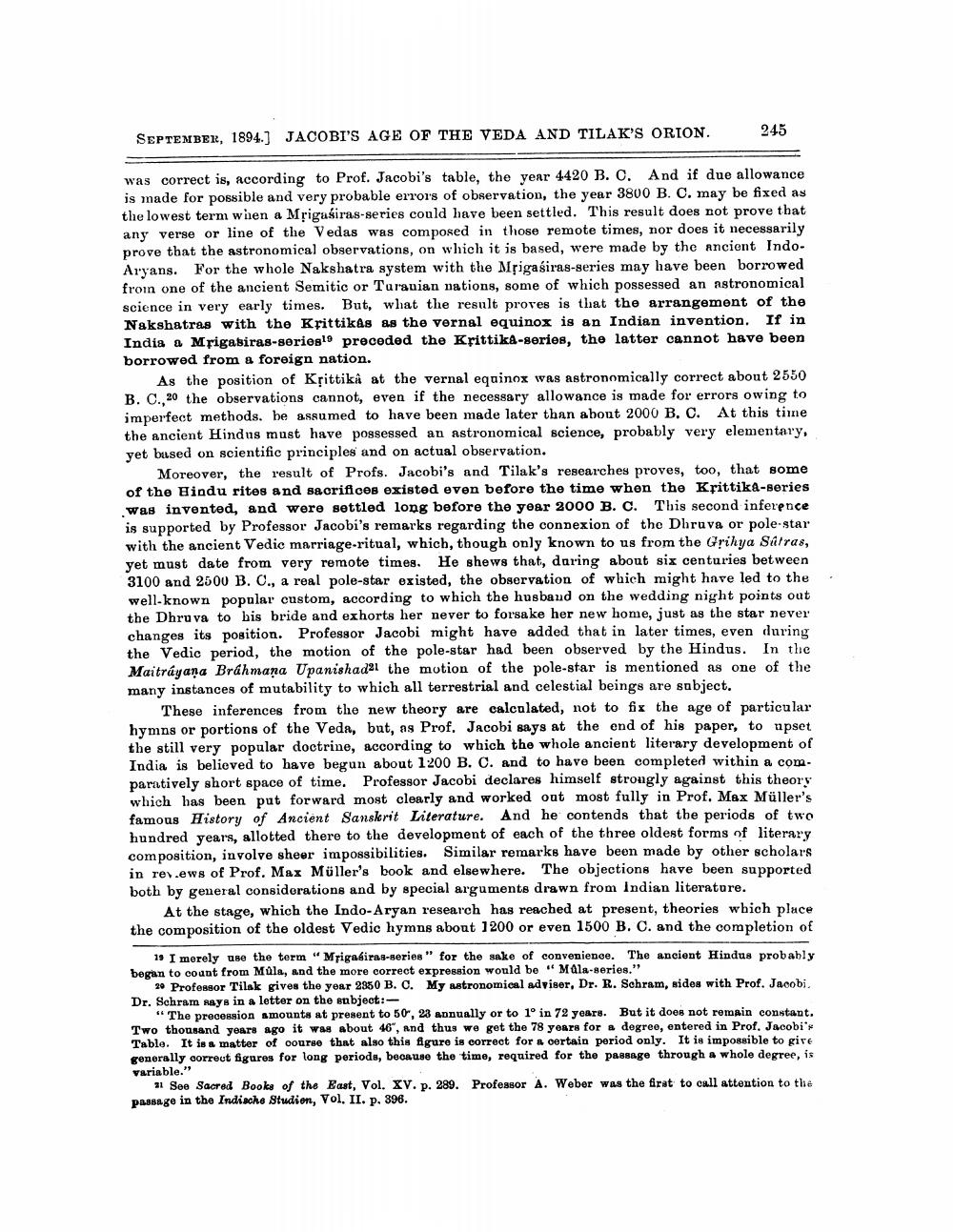________________
SEPTEMBER, 1894.) JACOBI'S AGE OF THE VEDA AND TILAK'S ORION.
245
was correct is, according to Prof. Jacobi's table, the year 4420 B. O. And if due allowance is made for possible and very probable errors of observation, the year 3800 B. C. may be fixed as the lowest term when a Mrigasiras-series could have been settled. This result does not prove that any verse or line of the Vedas was composed in those remote times, nor does it necessarily prove that the astronomical observations, on which it is based, were made by the ancient IndoAryans. For the whole Nakshatra system with the Mrigasiras-series may have been borrowed froin one of the ancient Semitic or Tarauian nations, some of which possessed an astronomical science in very early times. But, what the result prores is that the arrangement of the Nakshatras with the Krittikas as the vernal equinox is an Indian invention. If in India a Mrigabiras-sorioglo preceded the Ksittika-series, the latter cannot have been borrowed from a foreign nation.
As the position of Kțittika at the vernal equinox was astronomically correct about 2550 B. C.,20 the observations cannot, even if the necessary allowance is made for errors owing to imperfect methods. be assumed to have been made later than about 2000 B. C. At this time the ancient Hindus must have possessed an astronomical science, probably very elementary, yet bused on scientific principles and on actual observation.
Moreover, the result of Profs. Jacobi's and Tilak's researches proves, too, that some of the Hindu rites and sacrifices existed even before the time when the Krittika-series was invented, and were settled long before the year 2000 B. C. This second inference is supported by Professor Jacobi's remarks regarding the connexion of the Dhruva or pole star with the ancient Vedic marriage-ritual, which, though only known to us from the Grihya Sátras, yet must date from very remote times. He shews that, daring about six centuries between 3100 and 2500 B. C., a real pole-star existed, the observation of which might have led to the well-known popular custom, according to which the husbaud on the wedding night points out the Dhruva to his bride and exhorts her never to forsake her new home, just as the star never changes its position. Professor Jacobi might have added that in later times, even during the Vedic period, the motion of the pole-star had been observed by the Hindus. In the Maitráyaņa Brahmana Upanishad21 the motion of the pole-star is mentioned as one of the many instances of mutability to which all terrestrial and celestial beings are subject.
These inferences from the new theory are calculated, not to fix the age of particular hymns or portions of the Veda, but, as Prof. Jacobi says at the end of his paper, to upset the still very popular doctrine, according to which the whole ancient literary development of India is believed to have begun about 1200 B. C. and to have been completed within a com. paratively short space of time. Professor Jacobi declares himself strongly against this theory which has been put forward most clearly and worked out most fully in Prof. Max Müller's famous History of Ancient Sanskrit Literature. And he contends that the periods of two hundred years, allotted there to the development of each of the three oldest forms of literary composition, involve sheer impossibilities. Similar remarks have been made by other scholars in rev.ews of Prof. Max Müller's book and elsewhere. The objections have been supported both by general considerations and by special arguments drawn from Indian literature.
At the stage, which the Indo-Aryan research has reached at present, theories which place the composition of the oldest Vedic hymns about 1200 or even 1500 B. C. and the completion of
19 I morely use the term "Mrigabira-series" for the sake of convenience. The ancient Hindus probably began to count from Mola, and the more correct expression would be “Mala-series."
20 Professor Tilsk gives the year 2850 B. C. My astronomical adviser, Dr. R. Schram, sides with Prof. Jacobi. Dr. Schram rays in a letter on the subject:
"The precession smounts at present to 50, 23 annually or to 1° in 72 years. But it does not remain constant. Two thousand years ago it was about 46", and thus we get the 78 years for a degree, entered in Prof. Jacobi's Tablo. It is a matter of course that also this figure is correct for a certain period only. It is impossible to give generally correct figures for long periods, because the time, required for the passage through a whole degree, is variable."
1 Soe Sacred Books of the East, Vol. XV. p. 289. Professor A. Weber was the first to call attention to the passage in the Indiache Studion, Vol. II. p. 396.




